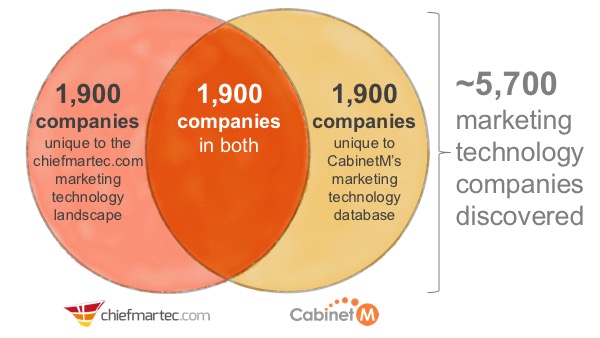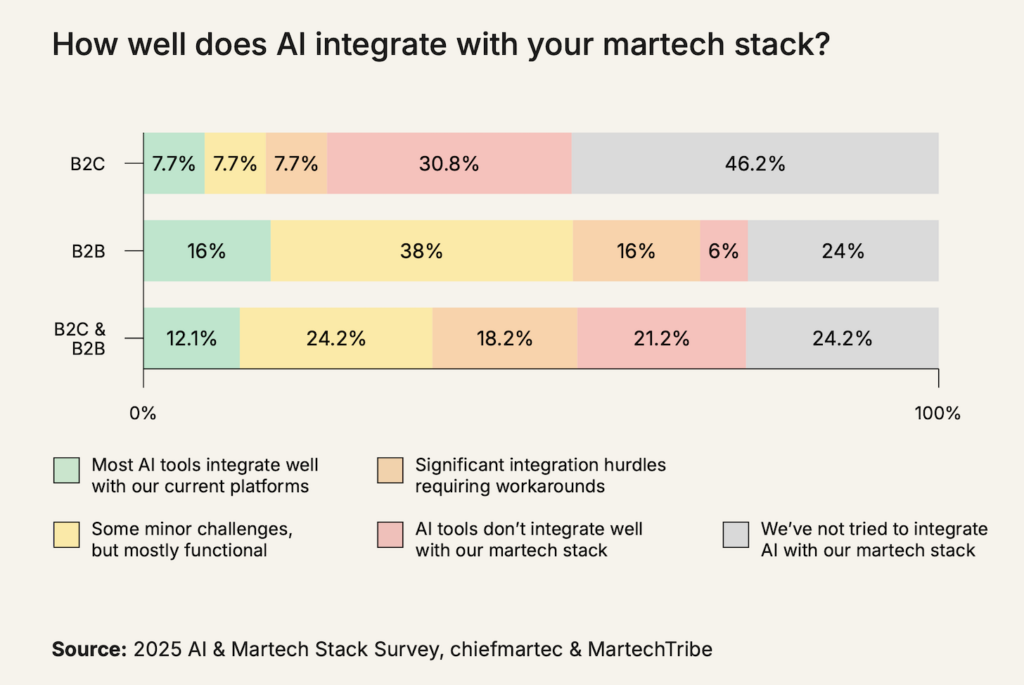Whenever I disclaim that my gigantor marketing technology landscape graphic is only a “representative sample” — that there are actually many more martech companies out there than I’ve been able to discover and include — I get the sense that most people consider it simply fine print.
“Sure, Scott, you’re disclaiming that so as to not offend a handful of a companies that you might have inadvertently left out,” I imagine them thinking. “But you’ve got 3,800 marketing technology solutions on that beast of a PowerPoint slide — which is already way too many to comprehend. It’s just not conceivable that there are many more than that.”
Well, prepare to quote Vizzini of The Princess Bride, “Inconceivable!”
The good folks at CabinetM, who’ve built a terrific marketing technology discovery and management service, recently shared with me a list of all the martech vendors that they’ve identified in the world, and — hold on to your butts — they found 1,900 marketing technology companies that weren’t on my landscape.
They didn’t want to release their whole database here, naturally, but I’ve seen their list, and it’s true. They found a whole boatload of martech vendors that I missed. (Ironically, when they looked at my 2016 marketing technology landscape, I had found about 1,900 companies that they missed in their original research.)
Deep breath.
Here’s a Q&A I had with CabinetM’s CEO, Anita Brearton, to get her perspective first-hand (and share a little bit about their service, which I find very cool):
1. How many marketing technology companies did you find that aren’t listed on my landscape?
We found close to 1,900 companies that are in CabinetM’s database that are not on the 2016 landscape.
2. Are there particular categories or kinds of companies that I especially overlooked?
The products in our database that are not on your landscape show up in almost all of our categories, with the key concentration in advertising, analytics, content, productivity, social media, and email.
3. How did you find these companies?
We’ve sourced these products through a variety of ways — lists, searching, and user feedback. A great side benefit of what we are both doing is that we are uncovering a lot of MarTech innovation happening outside the USA. It’s great to see the surfacing of innovative products from the UK, Australia, Europe, Israel, and India. I think we’ve just scratched the surface in cataloging MarTech companies outside the USA.
4. Is this the complete picture as of today, or do you think there are still more companies out there that neither of us have discovered yet?
I think between us we have the most comprehensive snapshot of the industry today. While there are some products we have that you don’t, you also have companies on your landscape that we don’t have in our database; we are also actually missing close to 1,900 companies. We are currently working to add those companies to our database. And here’s the freaky thing — 1,900 companies unique to us, 1,900 companies unique to you, and 1,900 companies in common — what’s that all about?
It’s really quite extraordinary to think about the sheer volume of available products. Even with our collective efforts, we’ve still got work to do. Just yesterday, one of our large enterprise customers using our stacks configurator to manage their technology suite asked us to add 17 products that weren’t currently on our database or in your landscape — yikes!
5. Have we reached “peak martech” in terms of the total number of active companies, or do you think the landscape is still expanding? Why?
I think we are probably getting close to a peak number, but that doesn’t mean that innovation halts. It does mean, however, that the industry will continually reshape itself. There are a number of factors impacting the overall size of industry:
- Not all companies will make it. We are continually reviewing our database to make sure the companies we’ve profiled are still alive.
- Companies are being acquired and products are changing names. What might look like a new product is actually an existing product with a new name.
- We don’t yet have a full picture of the global tools and technology environment. I think we have a lot left to uncover outside the USA.
- The boundaries between sales, marketing and IT are very fuzzy. I’m sure you struggle like we do in deciding whether to categorize some tools as MarTech tools, particularly in the areas of big data, analytics, productivity and web development.
Our litmus test is to ask the following questions, and if the answer is yes to any of them, we are generally inclined to include it:
- Is this something marketing will use?
- Is this something that marketing will buy?
- Is this something that IT or sales will buy that marketing will use or be involved in assessing?
One of the most interesting areas of innovation is sales enablement. With the functional lines blurring between marketing and sales, as more purchasing happens online, our plan is to include tools in that category on our site. We’ve made a start in that area, but we think there is much more to uncover.
Innovation will always be needed, particularly as it gets harder and harder to reach new customers in an increasingly fragmented landscape — and to keep existing customers connected in a meaningful way.
6. What advice would you give to marketers who are trying to wrap their heads around this dizzying array of choices? How do they leverage this to their advantage?
I think sometimes I sound like a broken record, but I firmly believe that you have to start with your stack. Creating a stack provides a framework to assess where you are, to see how well your technology mix matches up with your marketing objectives, to find where you have gaps and where you have the opportunity to integrate tools for a better marketing outcome.
It also gives you a platform to work collaboratively with IT in defining a technology roadmap and a baseline to show peers in order to solicit their recommendations.
Cutting edge digital teams are leveraging multiple stacks (products in use, products in test, products that have been retired) and taking a cut at stack topology by geographic location, business unit, or buyer journey.
Stacks are not just pretty pictures for PowerPoint presentations. They are quickly becoming the efficient way to visualize and manage a marketing technology product portfolio. We encourage every digital team to get started by auditing the tools that are being used across the organization.
Of course, as you know, we make that easy with our stack configurator. Our basic configurator is free and easy to use. For companies that need to work collaboratively and need to capture information about marketing technology that has been developed internally (a.k.a. dark martech), we have an enterprise offering to help with that. With your “we are here” stack in place it becomes much easier to assess where new technology products might fit into your environment and into your marketing mix.
7. How does all this diversity in marketing technology products translate into skills that marketers can train and hire for? Is that landscape equally diverse?
The days of the digital marketer title are just about done. What does that actually mean? It could describe someone who knows how to use two email platforms or someone who has a broad range expertise from the top of the funnel to the bottom.
The marketing organization is reshaping itself in response to the massive shift to digital programs. New specialist functions are becoming common (e.g., social media maven, content marketing specialist, demand gen expert). We’re also seeing more and more companies funding a marketing operations function to ensure that someone in the organization has responsibility for making things work together and monitoring the performance of all the tools being used.
This is a great time to be in marketing — there are so many areas of specialization and competent marketers are in high demand. Today’s modern marketer needs to showcase their technology competencies as well as their core marketing skills when applying for a job or promotion.
To complement our stack configurator we’ve now launched a SkillStack configurator to enable marketers to showcase their technology proficiency. With the free and easy to use SkillStacks, marketers can create their own personal marketing stacks and annotate each element with their level of proficiency. Once created, they can share their SkillStack with their team, managers and potential employers, and embed it on their LinkedIn profile with a custom link to show on their resume. Within an enterprise, marketing leaders can ask their team members to share their SkillStacks and quickly obtain an overview of the technology skills within their organization.
Thanks, Anita!




This is stunning ans scary at the same time. Hats off to you both for the mutual discovery and work towards one Universal MacroStack. One more example of the social web – it’s the long tail that contains the future. And bringing the Global axis is a great, great contribution. Anita, I hope you can find a way to enable CabinetM to become the watering hole where conversation and UGC can help us all find the gems and avoid the catastrophes within.
I totally agree that our own stacks are a vital first step, but will continue to assert that if there aren’t “why” and “to what end” axes to them, it’s just organizing a toybox.
Great and provocative post!
Stop holding out on us Anita 🙂
Peak martech? We’re only getting started.
No way this is a peak of MarTech…no flippin’ way. Just look at recent acquisitions, there is so much money to be made. Staking a foothold niche in hopes to be bought out. I predict may boutique MarTech co’s to start appearing. Holding onto my butt Scott.
I wonder what percentage of those vendors are selling vaporware though, or are actually mechanical turks. Especially in the “AI” field.
This article alludes to multi-vertical solutions and custom solutions, labelled as ‘dark martech’. Furthering this notion, many industry specific technologies also provide useful marketing solutions or even capabilities often in combination with multi-vertical solutions and custom development. There are thousands of solutions that exist and thousands more being dreamed of today. Each has a unique set of capabilities and the quandary for any CMO and their marketing team is to decide what MarTech infrastructure fits with their organization’s maturity and provides the level of flexibility they will need as their business continues to change.